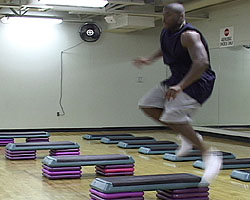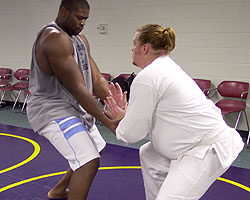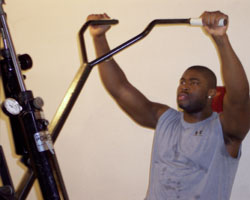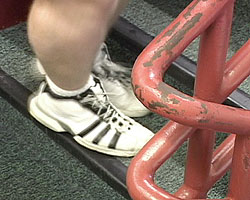The Ping Method
The Ping Method has proven over a number of years to be a useful adjunct to the programs of conditioning and rehabilitation of professional athletes. It combines the best of Eastern philosophy and medicine with the latest in Western conditioning and rehabilitative physiology. This unique combination allows the professional athlete to maximize his potential, decrease the incidence of injury, and accelerate the rehabilitation process. The following is a brief overview of his method.

Principles and Philosophy
The following are the foundational principles behind the method.
1. Athletic performance is the sum of physical skills, strength, conditioning, flexibility, and mental attitude or spirit. A well-rounded program must address all of these and approach each athlete as a whole person.
- Development of a program to optimize performance is guided by analysis of the metabolic and physical demands of professional football (sports?).
- The athlete’s cycle of conditioning varies depending upon timing (being in season or out of season), muscular maturity, and phase of career.
- Muscular anaerobic endurance is essential.
- Speed and agility of lower and upper extremities and the coordination of both in functional movements is essential.
- The ability to demonstrate explosiveness, defined as generating maximum power in the shortest duration of time, is essential.
- Hand/eye coordination and rapid reaction time are essential.
- Flexibility is essential to maximize performance and minimize the threat of injury.
- The tissues of the human body are stress dependent, and the best recovery from injury occurs with early appropriate movement.
The Ping Method is also shown in three movies available on the site:
Conditioning
Broadband
JuJitsu
Broadband
Hydra Gym
Broadband
Training
Preparations for an athlete to achieve his full potential are multifaceted. Each athlete is evaluated based on the demands of his position and his current physical condition. An individualized program is then implemented in the following areas to assist the athlete to reduce or eliminate areas of weakness, inflexibility, or potential injury.
Jishukan Ryu Jujitsu:

The art form of Jujitsu dates back to the 14th century. The specific style of Jishukan Ryu Jujitsu was created in the Showa Era (20th century). The art form comprises several areas of study. The athletes focus mainly on Kempo, offensive and defensive techniques using the human body as a natural weapon, punching, kicking, striking and blocking.
The athletes work individually performing punches and kicks emphasizing quick explosive movements and muscular endurance through a full range of motion. They perform several types of kicks. Repetitions often involve sets of 100. The front kick in particular benefits the hamstring. The hamstring works at high speeds, similar to running both concentrically and eccentrically. This conditioning reduces the likelihood of injury during the season. Side kicks and roundhouse kicks assist in conditioning of the hip abductors to enhance lateral mobility.
The practice of punches, such as double, triple, and step punch drills, helps develop fatigue resistant musculature and enhance recruitment of type II muscle fibers. Athletes also work with traditional students in drills demanding quick foot speed and rapid change of direction. These drills also develop hand/eye coordination and improve reaction time.
Resistance Training
One of the goals of Dr. Ping’s program is to develop the injury-resistant athlete. This goal is considered in the creation of all areas of the program, including resistance training. The athletes must be strong; however, they must also have muscular endurance and flexibility to eliminate fatigue on the field and reduce injury. In a sense, one can compare athletes to oak or bamboo trees. Both are strong. However, in the face of severe conditions such as storms and high winds, the oak will break due to its inflexibility. The bamboo, on the other hand, has the capacity to bend without breaking and survive the storm.
Many traditional programs place emphasis on power and lack endurance, which may lead to injury. Dr. Ping’s program addresses both areas. This is evident in the types of resistance used, the design of the routine and rest times, and the types of exercise selected. For example, pull-ups are performed on a towel draped over the pull-up bar. The athlete grabs the towel much like climbing a rope. This not only targets the latissimus dorsi and biceps, but improves abdominal and hand strength as well.
Free Weight Training

Free weight training is performed on Monday, Wednesday, and Friday. Monday and Wednesday, 3 sets are completed for each exercise at a weight the athlete can sustain for all 3 sets. Fridays are overload days on the bench press. The athlete performs multiple sets of gradually decreasing reps and increasing weight. It is extremely important for one to feel the free weights and understand the importance of balance and the freedom it gives.
Hydraulic Resistance Training

Unique to Dr. Ping’s program is the use of hydraulic resistance machines. First used in the early 1980s, hydraulic resistance or the Hydragym has proven a valuable adjunct to the program. The machines use variable, accommodating hydraulic resistance which is set up to require the athlete on any one exercise to not only push, but also pull against resistance to return to the start position. This type of continual resistance adds to the muscular endurance required for football. Dr. Ping has designed a circuit that is completed 3 times, 25 repetitions per station. This circuit program has produced improved cardiovascular endurance and recovery time. The Hydragym is used Tuesday, Thursday, and Saturday.
Aquatic Exercise

Aquatic exercise is used both for conditioning and rehabilitation. On Tuesday, Thursday, and Saturday, healthy athletes perform the following program. They stand and jump to clear the knee of the water, 10 sets of 20 seconds. They also swim 7 lengths of the pool. This is performed by swimming the length and getting out of the pool to walk back to the starting end, the walk being the recovery time.
The pool is also used to perform early, protected exercise in the case of injury. This early, careful intervention has reduced recovery time for such persistent injuries as hamstring strains. The athlete stands at the side of the pool holding the edge and performs exercise either against the resistance or with the assistance of the water, depending upon their stage of recovery.
Plyometrics

Training agility does not end with Jujitsu. Plyometrics are incorporated, utilizing a 7-inch step. The athlete jumps up and down from the step, varying between 3 positions. This is done for 7 sets of 60 seconds, on Tuesday, Thursday, and Saturday.
Running
The running program consists of the following sprint routine to develop speed, acceleration, and anaerobic conditioning. The running program is performed Tuesday, Thursday, and Saturday.
10 x 60 yards
7 x 110 yards
7 x 220 yards
7 x 440 yards
In addition to running, the athletes perform “Mountain Climbers,” 3 sets of 60 seconds on these same days.
Flexibility
Stretching occurs with every training session. A combination of static hold and contract-relax techniques is employed. To maintain gains and continue improvement, the athlete utilizes his full range of functional motion at every opportunity. It is this persistent use of full range of motion in the Jujitsu training that produces superior results.
Injury Prevention
Professional football injuries fall into two main categories: preventable (or at least decreasable incidents) and non-preventable. The latter refers to major injury that is inherently a risk of the profession such as helmet to knee contact, broken bones, etc. These are a result of major trauma during the course of play. While these injuries may be decreased with proper conditioning, and the recovery shortened with appropriate treatment, they are nevertheless the inevitable result of collisions on the field.
The former group of more preventable injuries involves those that arise from the cumulative trauma of overuse/under-conditioning (strains, sprains, back pain, etc). While often a player may miss only a few games a season because of such injuries, there is a strong likelihood of the accumulation of such injuries, shortening the career of a player and affecting his health in retirement. By addressing these adequately, the team is sending the message to the player that his health is not only important now but also after his playing career is over.
Factors contributing to preventable injuries include:
- Decreased endurance
- Areas of weakness overlooked in training
- Decreased flexibility
- Lack of mental focus
- Poor biomechanical habits used on and off the field
Dr. Ping’s prevention program addresses the elimination of the above risk factors.
Treatment of InjuryRehabilitation after injury is multifaceted, and decision-making is highly individualized. However, Dr. Ping has identified key principles that guide the athlete’s rehabilitation process.
- Physiological stress dependence of healing tissue.
Early appropriate activity (either tensile or contractile or both) enhances the quality of tissue repair.
2. Areas not involved should be maintained with vigorous exercise.
This accomplishes the following:
- Decrease of muscle atrophy
- Increase of blood flow for healing
- Maintains athlete’s psychological edgea positive attitude and belief in full recovery reduces the likelihood of psychological barriers to successful rehabilitation
- Decrease in anxiety
- Sends message to athlete that this is a temporary situation and full recovery is expected
General Phases of Rehabilitation
- Protection
- ROM
- Strength/endurance
- Power/explosive movements
- Position specific training
ProtectionROMStrength/endurancePower/explosive movementsPosition specific training
Throughout the above process, alternative medical treatment is available to stimulate the natural healing process and shorten recovery time.
Conclusion
Training in Jishukan Ryu Jujitsu is an excellent complementary component for the strength and conditioning of professional football players. The training is multifaceted and individualized to target areas requiring improvement to assist an athlete in achieving his maximum potential. Dr. Ping has been employing such training, combined with today’s Western approach in strength and conditioning, to achieve optimal performance enhancement of his athletes for 20 years.